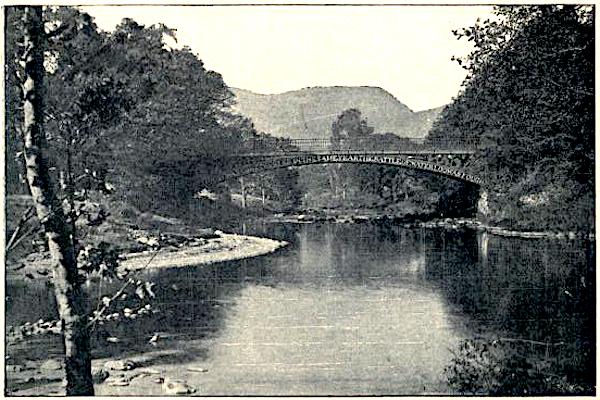
Waterloo Bridge, over the River Conwy at Betws-y-coed, N. Wales. Thomas Telford (1737-1834). Colin Price writes that, despite its proud declaration that "This bridge was constructed in the same year the Battle of Waterloo was fought," the arch was actually completed in the following year. It has been refurbished and strengthened over the years. Telford’s work is nonetheless among the oldest surviving cast iron bridges in the world. It is Grade I listed, and the listing text explains that it was built as
an important part of the new Shrewsbury to Holyhead road (A5), itself a heroic achievement in contemporary engineering and road building terms. The Waterloo Bridge, originally known as Llynnon Bridge, is thought to be the seventh major iron bridge in the world and with a span of over 30m is an impressive example of early iron technology. Its patriotic decorative expression and jingoistic dating inscription reveal a spirit of pioneering confidence and optimism during this important period of Britain's industrial and political growth.


Left: Closer view of the decorative ironwork. Right: Photo (by Isaac Slater) in A Guide to Bettwys-y-Coed, facing p. 18.
Betws-y-coed was very popular with the landscape artists of the Victorian age, some of whom established a little colony here, coming regularly in the summer months. They would no doubt have appreciated this attractive bridge, and it did feature in guide books, but other bridges in the area (especially the steeply inclined Miner's Bridge over the Llugwy, which joins the River Conwy here) seem to have garnered more attention.
Links to related material
Photograph by Colin Price, and text by Price and Jacqueline Banerjee. You may use the image without prior permission for any scholarly or educational purpose as long as you (1) credit the photographer and (2) link your document to this URL in a web document or to the Victorian Web in a print document. [Click on the image to enlarge it.]
Bibliography
"Waterloo Bridge." British Listed Buildings. Web. 10 March 2022.
A Guide to Bettwys-y-Coed and Llanwrst with notices of Capel Curig, Trefriw, and Dolwyddelaf. Manchester: Abel Heywood / London: E. E. Allen, 1903. Internet Archive. Contributed by University of California Libraries. Web. 13 March 2022.
Created 13 March 2022